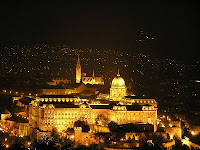Buda Castle is the historical castle complex of the Hungarian kings in Budapest, Hungary first completed in 1265. In the past, it was also called Royal Palace and Royal Castle. Buda Castle was built on the southern tip of Castle Hill, next to the old Castle District, which is famous for its medieval, Baroque and 19th century houses and public buildings. It is a famous tourist destination linked to Adam Clark Square and the Szechenyi Chain Bridge by the Castle Hill Funicular. Buda Castle is part of the Budapest World Heritage Site, declared in 1987.
 The lavishly decorated interiors of the palace were all destroyed during WW2 and the post-war reconstruction. There is very little data about the interiors of the medieval and Baroque era. The Hauszmann palace was meticulously recorded with detailed descriptions, photographic documentation and ground plans. The royal apartments created a 200 m long series of rooms, longer than any similar royal apartments in continental Europe except Versailles.
The lavishly decorated interiors of the palace were all destroyed during WW2 and the post-war reconstruction. There is very little data about the interiors of the medieval and Baroque era. The Hauszmann palace was meticulously recorded with detailed descriptions, photographic documentation and ground plans. The royal apartments created a 200 m long series of rooms, longer than any similar royal apartments in continental Europe except Versailles.The most important rooms in Buda castle are given here. The Ballroom on the first floor of the Baroque wing had several layers of Baroque decoration from the second half of the 18th and the 19th century. St. Sigismund Chapel or Castle Church is the palace chapel in the western end of this wing had no facades, only a door opening onto Lions Court. The church was consecrated in 1769. The Palatinal Crypt under the former palace chapel is now the only surviving room of the whole Royal Castle. The Great Ballroom in the middle part of the Northern Wing took over the function of the smaller old Ballroom. The monumental main staircase of the Krisztinavaros Wing with three flights was leading up from to the first floor in an airy, glass-roofed hall. The Habsburg Room was situated right in the middle of the long palace complex, under Hauszmanns dome.
A series of rooms from the medieval palace of the Hungarian kings were unearthed and reconstructed during the postwar rebuilding of Buda Castle in 1958-62. They are now part of the permanent exhibition of the Budapest History Museum in "Building E" of Buda Castle. Only a fragment of the medieval palace survived the destruction of 1686-1715 and the surviving rooms were not the most important ones of the original building. They were only saved by the chances of destruction and their geographical position, situated on a lower level then the newly created Baroque terrace.

 The rib vaulted Gothic Hall is one of the most important surviving example of secular Gothic architecture in Central Europe. It was built by King Sigismund Luxemburg of Hungary in the early 15th century. The three interconnected, barrel-vaulted rooms belong to the oldest part of the palace, the Stephen Castle. A great underground cistern under the - now disappeared - northern zwinger, the Cisterna Regia, survived the centuries of destruction as a cellar. The the 7 m high basement section of the eastern facade with the lower part of a fine Gothic balcony survived inside the later King's Cellar.
The rib vaulted Gothic Hall is one of the most important surviving example of secular Gothic architecture in Central Europe. It was built by King Sigismund Luxemburg of Hungary in the early 15th century. The three interconnected, barrel-vaulted rooms belong to the oldest part of the palace, the Stephen Castle. A great underground cistern under the - now disappeared - northern zwinger, the Cisterna Regia, survived the centuries of destruction as a cellar. The the 7 m high basement section of the eastern facade with the lower part of a fine Gothic balcony survived inside the later King's Cellar.The Royal Palace and its gardens were decorated with statues. The spectacular fountain is decorating the western forecourt of the palace. The equestrian statue of Prince Eugene of Savoy is standing on the Danube terrace, in a prominent position, high above Budapest. The statue of the Hortobagy horse wrangler taming a wild horse originally stood in front of the Riding School in the former Ujvilag terrace. The mythological Turul, high above the Danube, was made by Gyula Donath in 1905. The plinth and the ornate Neo Baroque rail were damaged during the siege of Buda but they were restored in 1981.







No comments:
Post a Comment